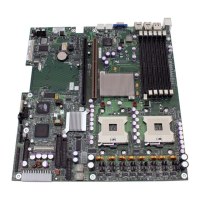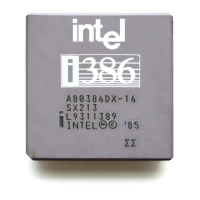Intel® Server Board SE7520JR2 Platform Management
Revision 1.0
C78844-002
119
These interfaces remain active on standby power, providing a mechanism where the SEL, SDR,
and recovery control features can be accessed even when the system is powered down.
Because the management controller operates independently from the main processor(s), the
management controller monitoring and logging functions, and the out-of-band interfaces can
remain operative even under failure conditions that cause the main processors, OS, or local
system software to stop.
The management controller also provides the interface to the non-volatile ‘Sensor Data Record
(SDR) Repository’. IPMI Sensor Data Records provide a set of information that system
management software can use to automatically configure itself for the number and type of IPMI
sensors (e.g. temperature sensors, voltage sensors, etc.) in the system. This information allows
management software to automatically adapt itself to the particular system, enabling the
development of management software that can work on multiple platforms without requiring the
software to be modified.
The following is a list of the major functions that are managed by either or both the mBMC and
Sahalee BMC.
• Sensors and Sensor Polling
• FRU Information Access. FRU (Field Replaceable Unit) information is non-volatile
storage for serial number, part number, asset tag and other inventory information for the
baseboard and chassis. The FRU implementation on SE7520JR2 includes write support
for OEM-specific records.
• Autonomous Event Logging. The management controller autonomously polls baseboard
sensors and generates IPMI Platform Events, also called Event Messages, when an
event condition is detected. The events are automatically logged to the System Event
Log (SEL).
• System Event Log (SEL). Non-volatile storage for platform health events. Events can be
autonomously logged by the BMC, or by sending Event Messages via the system
interface or IPMB to the BMC. This enables BIOS, software, and add-in cards to also log
events.
• Sensor Data Record (SDR) Repository. Non-volatile storage holding records describing
the number and type of management sensors on the baseboard and in the chassis.
Includes write support for OEM-specific records and sensors.
• SDR/SEL Timestamp Clock. A clock internally maintained by the management controller
that is used for time-stamping events and recording when SDR and SEL contents have
changed.
• Intelligent Platform Management Bus (IPMB). The IPMB is a two-wire, multi-master
serial bus that provides a point for extending the baseboard management to include
chassis management features, and for enabling add-in cards to access the baseboard
management subsystem. (Professional and Advanced systems only.)
• Watchdog Timer with selectable timeout actions (power off, power cycle, reset, or NMI)
and automatic logging of timeout event
• Direct Platform Control (DPC) LAN Remote Management Connection
• LAN Alerting via PET (Platform Event Trap) format SNMP trap
• Serial/Modem Remote Management Connection (Professional and Advanced systems
only)
• Serial/Modem Event Paging/Alerting (Professional and Advanced systems only)

